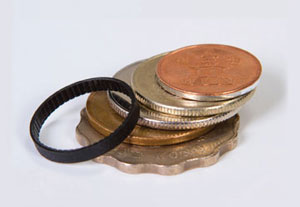March 2, 2011

Aleading global printer and copier manufacturer is using what may be the world'ssmallest timing belt in an application that requires a very small belt forpaper media transfer. The belt replaces a rubber o-ring with inherent drawbacksincluding loss of shape and decay of tension over time due to stretch a circularcross-section which did not allow formuch surface contact and marking of the paper media.
"Forthis application, the customer was looking for a very small belt to drive twoshafts in the same direction for paper media transfer," says Hans Raj, technicalbusiness development manager for Fenner Precision. "Space requirements, maintaining coefficient of friction andavoiding any loss of tension over time were main concerns. These requirementsprevented the manufacturer from using conventional solutions such as smallO-ring or gears."
Miniature Timing Belt |
Atthe time they initially looked at the design, Fenner Precision didn't have a beltsmall enough (53 mm pitch length) in its product portfolio. So the coredevelopment was the challenge of enhancing its product and manufacturing capabilitiesto create these smaller-than-ever miniature belts.
Thedesign challenges for the new construction included miniature size, constant tensionand a reliable surface over the life of the belt. In addition, the ability tonot mar or bend the media during the transfer motion was a must. To achieve theseoverall design objectives, Fenner modified the belt material to provide ahigher and more consistent coefficient of friction and used a specializedmolding/de-molding process to make the smaller belt.
Theend product is a 53 mm inside length belt constructed of a special polyurethanecompound reinforced with fiberglass. This reinforcement prevents stretching, sothat the belt does not lose its shape or decay over time, and the polyurethanedoes not mark the paper. The belt's unique surface allows it to have morecontact area with the paper, as opposed to the minimal surface contact providedby an o-ring. In addition the belt is washed and textured to increase its frictionalproperties.
"Wecreated a reinforced belt solution to respond to a particular customer need,"says Raj. "This new belt solution can be utilized as either a drive belt or mediatransfer belt as it maintains both tension and a high coefficient of frictionover time."
Usingurethane reinforced with fiberglass is a technique that Fenner Precision hasused on other larger belts but, for this application, they applied the specialsurface finish to provide a good texture and increase the reliability ofinterfacing other secondary operations and using different production batches. TheFenner engineering team also came up with manufacturing solutions and specialhandling tools to reliably mold and de-mold the extremely small belts to meetthe customers demanding quality and high volume requirements.
"Interms of applications, this same profile can be a potential replacement forgears and O-rings in a wider variety of designs," says Pete Haberbosch, Global VPSales and Marketing for Fenner Precision. "The compact size can provide new solutionsfor designers of small medical devices, portable printers, scanners and othernew applications."
Haberboschsays many customers are designing smaller devices. The trend is focused onsolutions that can fit into smallerpackages to reduce space and costs requirements.
Withapplications that require shaft-to-shaft motion and travel in the samedirection, the design advantage of mini pitch belts over using gears is thatthe system requires only two shafts rather than three. Belts can also providespace savings versus using gears, and belt systems also tend to create lessvibration and noise. In addition because the belt doesn't have anymetal-to-metal or plastic-to-plastic interfaces, lubrication can be avoided.
About the Author(s)
You May Also Like






